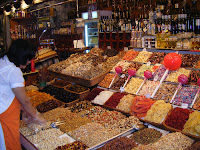
We spent a relaxing weekend here in Valencia exploring the city and trying to catch up on our homework. On Friday evening we went to one of the main squares in the historic district and tried agua de Valencia, one of the most popular beverages here comprised of orange juice, gin, vodka, champagne, and lots of sugar. On Saturday we visited the Palacio del Marqués de Dos Aguas, with its amazing alabaster facade and interesting ceramics collection. Our instructor called it a "mini Versaille", but we're hoping for more when we visit the actual Versaille in two weeks. It was most interesting to see traditional ceramics alongside modern works of art, including 5 plates by Picasso. We spent Sunday morning at the beach, reading on the shore and swimming in the Mediterranean.
On Monday we watched a Spanish film after class entitled Los Amantes del Círculo Polar (Lovers of the Arctic Circle). It was beautiful, deep and thought-provoking, even without English subtitles. We particularly enjoyed getting to hear our instructor's interpretations of the film and talk about the symbolism. We would definitely recommend this film to anyone.

The same evening we attended Wagner's opera Das Rheingold at Valencia's Palau de les Arts Reina Sofia. In addition to impeccable singing (confirmed by an
opera student who came with us), the choreography, costumes, and scenery corresponded to the architectural design of the building. That is to say, it was very modern, using three-dimensional technological effects, human bodies to represent gold and other material resources, and an outer space-like setting for the gods. It was well worth the price to get to experience a small part of the huge music festival that is taking place right now. People are coming from around the world to attend Wagner's cycle of operas entitled Der Ring des Nibelungen, as well as participate in concerts, and discussions.
We've also visited the Lladró factory, the only sight in the world where these valuable porcelain figures are handmade, and the Museum of las Fallas. Las Fallas is a festival held yearly in Valencia, of which Valencianos are extremely proud. Hundreds of giant paper-mache statues are constructed as part of a competition. At the conclusion of the week-long festival one is chosen as the winner and all the rest are burned. The museum contains the life-size figure that won for each year from 1930 to the present (except for the years during the Spanish Civil War). It was interesting to see how the emphasis on theme and designed changed over the years, especially after having just studied 20th century Spanish history.


